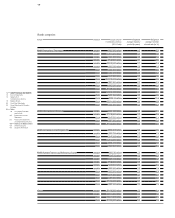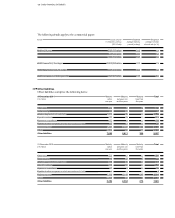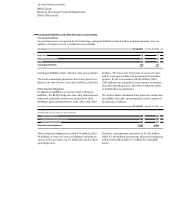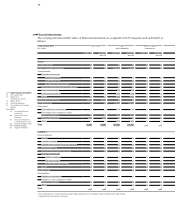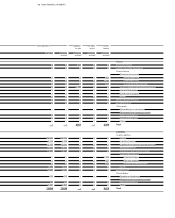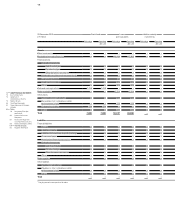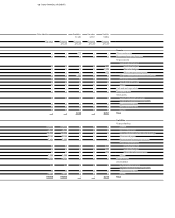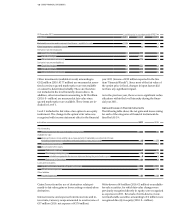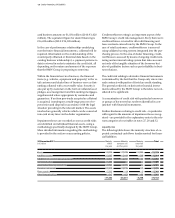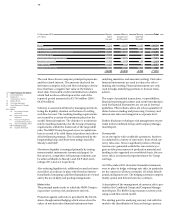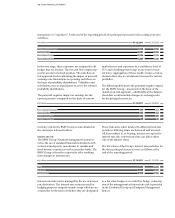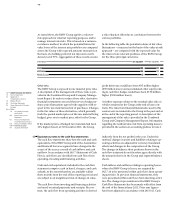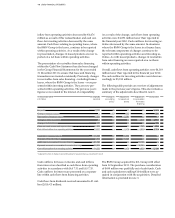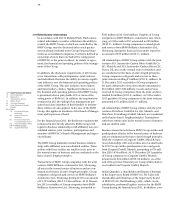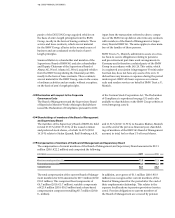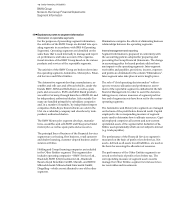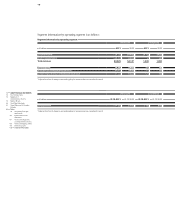BMW 2011 Annual Report Download - page 136
Download and view the complete annual report
Please find page 136 of the 2011 BMW annual report below. You can navigate through the pages in the report by either clicking on the pages listed below, or by using the keyword search tool below to find specific information within the annual report.
136
76 GROUP FINANCIAL STATEMENTS
76 Income Statements
76 Statement of
Comprehensive Income
78 Balance Sheets
80 Cash Flow Statements
82 Group Statement of Changes
in Equity
84 Notes
84 Accounting Principles
and Policies
100 Notes to the Income
Statement
107 Notes to the Statement
of Comprehensive Income
108
Notes to the Balance Sheet
129 Other Disclosures
145 Segment Information
Fair value gains and losses recognised on derivatives
and recorded initially in accumulated other equity are
reclassified to cost of sales when the derivatives ma-
ture.
Losses amounting to € 2 million (2010: € 24 million) at-
tributable to forecasting errors (and the resulting over-
hedging of currency exposures) were recognised as an
expense within the line item “Financial Result” in the
financial year 2011. These forecasting errors, which all
related to the year under report, arise primarily as a
result of changes in sales forecasts in foreign currencies.
In addition, an expense of € 52 million (2010: income
of € 3 million) was recognised in conjunction with the
ineffective portion of cash flow hedges relating to raw
materials. These amounts were also reported in “Finan-
cial Result”.
At 31 December 2011 the BMW Group held derivative
instruments with terms of up to 54 months (2010: 60
months) to hedge currency risks attached to forecasted
transactions. It is expected that € 279 million of net losses,
recognised in equity at the end of the reporting period,
will be recognised in the income statement in 2012.
The difference between the gains / losses on hedging
instruments and the result recognised on hedged items
represents the ineffective portion of fair value hedges.
Fair value hedges are mainly used to hedge the market
prices of bonds, other financial liabilities and receivables
from sales financing.
At 31 December 2011 the BMW Group held derivative
instruments with terms of up to 60 months (2010: 72
months) to hedge interest rate risks. It is expected that
€ 10 million of net losses, recognised in equity at the
end of the reporting period, will be recognised in the
income statement in 2012.
At 31 December 2011 the BMW Group held derivative
instruments with terms of up to 55 months (2010: 35
months) to hedge raw material price risks attached to
future transactions. It is expected that € 18 million of
net g
ains, recognised in equity at the end of the re-
porting
period, will be recognised in the income state-
ment in 2012.
Cash flow hedges are generally used to hedge cash
flows arising in conjunction with the supply of vehicles
to subsidiaries and to hedge raw material price fluc-
tuations.
Fair value hedges
The following table shows gains and losses on hedging
instruments and hedged items which are deemed to be
part of a fair value hedge relationship:
Credit risk
Notwithstanding the existence of collateral accepted,
the carrying amounts of financial assets generally take
account of the maximum credit risk arising from the
possibility that the counterparties will not be able to
fulfil their contractual obligations. The maximum credit
risk for irrevocable credit commitments relating to
credit
in € million 31. 12. 2011 31. 12. 2010*
Gains / losses on hedging instruments designated as part of a fair value hedge relationship 213 – 239
Gains / loss from hedged items – 225 253
–12 14
* Prior year figures restated
in € million 2011 2010
Balance at 1 January – 127 209
Total changes during the year – 623 – 336
of which recognised in the income statement during the period under report – 68 274
Balance at 31 December –750 –127
The disclosure of interest income resulting from the un-
winding of interest on future expected receipts would
normally only be relevant for the BMW Group where
assets have been discounted as part of the process of de-
termining impairment losses. However, as a result of
the assumption that most of the income that is subse-
quently recovered is received within one year and the
fact that the impact is not material, the BMW Group
does not discount assets for the purposes of determining
impairment losses.
Cash flow hedges
The effect of cash flow hedges on accumulated other
equity was as follows:


